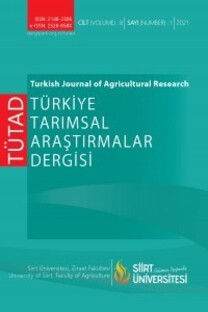Determination of the Sample Size on Different Independent K Group Comparisons by Power Analysis
Independent treatment comparisons, power analysis, effect size, sample size, F-t test, simulation
Determination of the Sample Size on Different Independent K Group Comparisons by Power Analysis
Independent treatment comparisons, Power analysis, Effect size, Sample size, Simulation, F-t test,
___
- Akkartal, E., Mendes, M., Mendes, E., 2010. Determination of suitable permutation numbers in comparing independent group means: a monte carlo simulation study. Journal of Scienctific & Industrial Research, 69(6): 22-425.
- Arıcı, Y.K., 2012. The effect of transformations on type I. error and test power in balanced factorial experiments. PhD Thesis, Ankara University Institute of Science and Technology, Ankara, Turkey. (In Turkish).
- Aslan, E., 2018. Power analysis for different test statistics. Master Thesis, Süleyman Demirel University Institute of Science and Technology, Isparta, Turkey. (In Turkish).
- Başpınar, E., 2001. Type I error and power of tests when applying the student's-t, welch and trimmed-t tests to two samples of various sizes from normal populations having various variance ratios. Journal of Agricultural Sciences, 7(1): 151-157. (In Turkish).
- Başpınar, E., Çamdeviren, H., Gürbüz, F., 1999. Determination of the power of the test and the appropriate sample size in Student t-test and variance analysis technique. Journal of Agricultural Sciences, 5(3): 116-123. (In Turkish).
- Başpınar, E., Gürbüz, F., 2000. The Power of the test in the samples of various sample sizes were taken from the binary combinations of the Normal, Beta, Gamma and Weibull Distributions. Journal of Agricultural Sciences, 6(1): 116-127. (In Turkish).
- Bossi, A., 2009. Power Calculation Tool For t-Tests, ANOVA and DOE 2k. Quantide.
- Boyar, S., 2019. Comparison of testsused in comparing independent two groups in terms of type 1 error and power of test. Master Thesis, Isparta Applied Sciences University Graduate Education Institute, Isparta, Turkey. (In Turkish).
- Cozby, P., Bates, S., 2012. Methods in Behavioral Research. McGraw-Hill, Newyork.
- Ellis, P.D., 2010. The Essential Guide to Effect Size, Statistical Power, Meta-Analysis and Interpretation Research Results. Cambridge University Press, New York.
- Fairweather, P.G., 1991. Statistical power and design requirements for environmental monitoring. Australian Journal of Marine and Freshwater Research, 42(5): 555-567.
- Keskin, S., Özsoy, A.N., 2004. Canonical correlation analysis and its an application. Journal of Agricultural Sciences, 10(1): 57-71. (In Turkish).
- Koşkan, Ö., Gürbüz, F., 2008. Resampling approach and comparison of t-test for type I error rate and test power. Journal of Animal Production, 49(1): 29-37. (In Turkish).
- Kul, S., 2011. Sample size determination for clinical research. Ekstraplevral, 2(2): 129-132.
- Lenth, R.V., 2007. Statistical power calculations. Journal of Animal Science, 85(13): 24-29.
- Lewis, K.P., 2006. Statistical power, sample sizes, and the software to calculate them easily. BioScience, 56(7): 607-612.
- MacCallum, R.C., Browne, M.W., Sugawara, H.M., 1996. Power analysis and determination of sample sizze covariance structure modeling. American Psychological Association, 1(2): 130-149.
- Mendeş, M., 2002. The Comparison of some alternative parametric tests to one - way analysis of variance about Type I error rates and power of test under non - normality and heterogeneity of variance. PhD Thesis, Ankara University Institute of Science and Technology, Ankara, Turkey. (In Turkish).
- Mendeş, M., 2004. ANOVA comparisons of ANOVA and F and K tests in terms of type III. Journal of Agricultural Sciences, 10(2): 121-126. (In Turkish).
- Mendeş, M., Yiğit, S., 2013. Comparison of ANOVA-F and ANOM tests with regard to type I error rate and test power. Journal of Statistical Computation and Simulation, 83(11): 2093-2104.
- Moder, K., 2010. Alternatives to F-test in one way ANOVA in case of heterogeneity of variances a simulation study). Psychological Test and Assessment Modeling, 52(4): 343-353.
- Muller, K.E., Benignus, V.A., 1992. Increasing scientific power with statistical power. Neurotoxicology and Teratology, 14(3): 211-219.
- Murphy,, K.R., Myors, B., 2004. Statistical Power Analysis, A Simple and General Model for Traditional and Modern Hypothesis Test. Routledge, London.
- Peterman, R.M., 1990. Statistical power analysis can improve fisheries research and analysis can improve fisheries research and management. Canadian Journal of Fish and Aquatic Sciences, 47(1): 2-15.
- Searcy-Bernal, R., 1994. Statistical power and aquacultural research. Aquaculture, 127(4): 371-388.
- Taylor, B.L., Gerrodette, T., 1993. The uses of statistical power in conservation biology: The vaquita and Northern Spotted Owl. Conservation Biology, 7(3): 489-500.
- Thomas, L., 1997. Retrospective power analysis. Conservation Biology, 11(1): 276-280.
- Thomas, L., Juanes, F., 1996. The importance of statistical power analysis: an example from animal behaviour. Animal Behaviour, 52(4): 856-859.
- Welch, B.L., 1951. On the comparison of several mean values: An alternative approach. Biometrica, 38(3/4): 330-336.
- Wilcox, R.R., 1989. Adjusting for unequal variances when comparing means in oneway and two-way effects ANOVA models. Journal of Educational Statistics, 14(3): 269-278.
- Yiğit, S., 2012. Type I error rate and test power for different approaches to factorial designs when normality and homogeneity of variances assumptions are not satisfied. Master Thesis, Çanakkale Onsekiz Mart University Institute of Science and Technology, Çanakkale, Turkey. (In Turkish).
- Zar, J.H., 2013. Biostatistical Analysis: Pearson New İnternational Edition. Pearson, New Jersey.
- ISSN: 2148-2306
- Başlangıç: 2014
- Yayıncı: SİİRT ÜNİVERSİTESİ ZİRAAT FAKÜLTESİ
Osman KILIÇ, Gamze AYDIN ERYILMAZ, Serdar ÇAKIR
İnsektisitlerin Böcekler Üzerindeki Subletal Etkileri
Saliha Selma ŞAHİN, Mehmet KEÇECİ
Determination of the Sample Size on Different Independent K Group Comparisons by Power Analysis
Emre ASLAN, Özgür KOŞKAN, Yasin ALTAY
Spatial Market Integration of Rice in the World
Sanusi SADIQ, Invinder Paul SINGH, Muhammad Makarfi AHMAD
Hıyar (Cucumis sativus L.) Bitkisinin Yüksek Sıcaklık Stresine Verdiği Antioksidant Cevaplar
Hamdullah SEÇKİN, İsmet MEYDAN
Çiğdem YAMANER, Mehtap ALKAN, Ebru ARSLAN HALAVURT, Taha Harun TEKİN
Vis-NIR ve pXRF Spektrometrelerinin Toprak Biliminde Kullanımı
Sevim ATMACA, Şeyda ŞİMŞEK, Zeliha KAYAASLAN, Gamze PEKBEY
Contributions to the Dance Flies (Diptera: Empididae) of Siirt Fauna, Turkey
